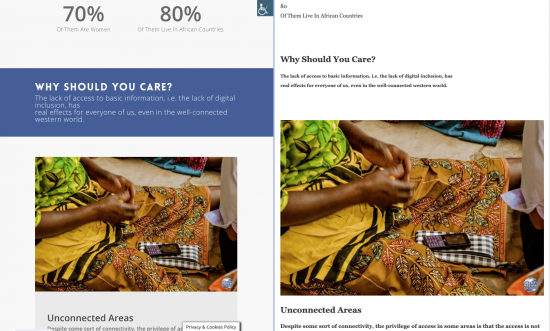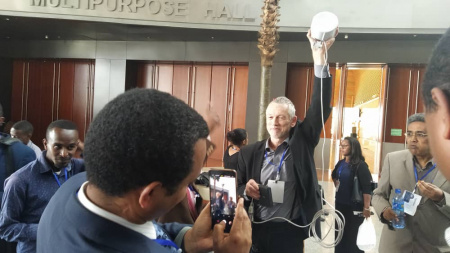Meeting with the Mexican Embassy in Oslo
| Wiki for ITS | ||||||
|---|---|---|---|---|---|---|
|
Meeting with the Mexican Embassy in Oslo
| Title | Meeting with the Mexican Embassy in Oslo |
|---|---|
| Place | Embassy of Mexico@Oslo |
| Date, Time | 2020/03/09, 1500-1630 |
| Contact Person | Jose-Juan Lopez-Portillo |
| Participants | Josef Noll, Juan Carlos Lopez Calvet, Jose-Juan Lopez-Portillo, HE Ulises Canchola Gutiérrez, Brenda Jimris-Rekve |
| related to Project | DigI, BasicInternet |
| Keywords |
| this page was created by Special:FormEdit/Meeting, and can be edited by Special:FormEdit/Meeting/Meeting with the Mexican Embassy in Oslo |
| Category:Meeting |
Purpose and Outcome
The Meeting was held to update each other on the activities around National Knowledge Portal, DPGs and DTCs, as well as discuss some of the upcoming challenges for national governments.
As major outcome, agreement was reached to deepen the dialogue:
- the Embassy asked for more information on both connectivity, the freemium model for access, as well as digital health and the envisaged National Knowledge Portal.
- The Embassy is interested in connecting the Basic Internet Foundation with necessary shareholders such as the Minister of Telecom, Ministry of Health, Ministry of Education.
- Regarding activities in Norway, the Embassy is interested in joining meetings such as the Visjon2030meetings
- The government of Mexico has an implementation committee in all issues regarding SDGs in Mexico. Activities to achieve the SDGs are highly regarded,
- The Split Architecture for Freemium Access to Internet has a clear potential to contribute to affordable Internet.
Introduction by the Embassy of Mexico
The Embassy of Mexico emphasises the need for change in order to answer the societal challenges. Some of the aspects being addressed were:
- The need to bring value and valuable services to the society (information is not enough)
- The need for digital empowerment to answer the challenges of Society5.0
- Mexico has an ambitious plan for a.o. national health, already providing apps for pregnant women
- The power of implementation should remain with the government, as digital inclusion is a societal challenge,
As for many other governments, challenges are
- to establish infrastructure, especially in rural areas. In this case, the government of Mexico has developed a health application for the pregnant women to help monitor their pregnancy
- to ensure that everyone has access to the Internet (equality for access)
- to provide good connectivity to the Internet, and ensure net neutrality. As part of the information collection, the government has had discussions with Mark Zuckerberg, the CEO of Facebook on how to provide solutions with regards to connectivity
Goals of the Basic Internet Foundation
This part is extended such that it can be shared directly with relevant shareholders.
In order to reach the targets for SDG 3 and SDG 4, digital inclusion and societal empowerment is a key area. The University of Oslo (UiO) and Kjeller Innovation have established the Basic Internet Foundation (BasicInternet.org), to foster solely on connecting the unconnected. The Foundation has established the the concept Internet Lite for All, the free access to information for everyone. furthermore, the Foundation
- has the vision to improve the life of every human through free access to information on the Internet
- promotes and provides the Freemium model for access
- builds Information spots with free access to information, and premium access to broadband services.
Basic Internet Foundation enforces the need to empower the society by fostering trust, and ensuring how this trust as a value proposition is achieved. This value proposition has all to do with the digital participation by the people.
The Government of Norway (Research Council of Norway, Norad and MfA) supports the work of the Foundation through the Non-discriminating Access for Digital Inclusion (DigI project), involving 11 partners from 9 countries. As part of the DigI project, the consortium has connected 10 villages in Tanzania (see DigI:Villages) and established the basis for local communities building information spots.
The provision of digital health information through publicly available information spots in remote villages has shown tremendous success.
The work of the Foundation was recognised by the United Nations' High-Level Panel on Digital Cooperation, and was cited as an example by the Norwegian Parliament Report Digital transformasjon og utviklingspolitikken (Stortinget Meld. St. 11, 2019–2020). See further details at DigI:Publications.
| Thumb | Title | Keywords | Date | Author/Project |
|---|---|---|---|---|
 |
Mexico National Knowledge Portal for Digital Inclusion Click to Open Meeting with the Mexican Embassy in Oslo |
Digital Inclusion, National Knowledge Portal, Society5.0 | 9 March 2020 | Josef Noll |
As explained in the presentation, the Foundation has achieved the following
- a cost-effective information spot consisting of a directive antenna, a local network controller and a village/school server. The total hardware costs are USD 300, thus about half of what a smartphone costs. Read more about the functionality at Basic Internet Information Spot
- Extending the reach of 3G/4G networks to more than 20 km, as done in Selela at the border of the Serengeti
- Providing connectivity to schools, and from there to the local society, as done at the Julius Nyerere High School in Migoli (Tanzania), and our blog describing the connectivity at the Nyerere High School
- Point of presence in 8 countries, out of which 5 are in Africa.
- Hackathon with community network members from 5 countries, to transfer knowledge and empower communities to build their own connectivity
- Seminar on school connectivity in rural areas, stating the need for OPEX costs as low as 20 USD/month, as well as content centric deployment to answer the need of the local community/school.
National Knowledge Portal for Mexico
Two major aspects are addressed through a National Knowledge Portal, being
- What is a National Knowledge Portal, and what content should reside on the Knowledge Portal
- How to enable free access of everyone in the society
Content on the National Knowledge Portal
Please see the Video by Digital Skills Foundation on the National Knowledge Portal- https://owncloud.basicinternet.org/index.php/s/TCH1zu9G5iL63qp
With regards to content creation on the portal, we had a longer discussion, touching into:
- What kind of content: Information for education, health, entrepreneurship and innovation, as well as governmental information are the obvious kinds of content to be provided through the knowledge portal. Best praxis: The government invites for content, including ministries, academics and private companies. As an example, the Digital Public Goods established by UNICEF could be made available through the knowledge portal
- Ownership of content: the government should set up the guidelines, and should ask the citizens and the local communities for their needs, such that the goal of empowering the society is reached.
- The Foundation suggests to establish a split architecture, between lightweight content (text and pictures) and heavy content such as videos. In order to effectively use the connectivity, heavy content should be provided through local points of presence.
The question of network neutrality by the Government of Mexico on the Knowledge Portal emphasised the need to "filter after the content type and not after the content". In our definition of Internet Lite we split the content after content types, e.g. text & pictures are provided through the Internet, while video and streaming content is provided locally. There is a need to define the set of protocols to characterise the lightweight content, with AMP being a protocolthat already satisfies the needs. See Figure 3 as an example, showing the normal and the AMP version of a Web page side-by-side:
- Full Web page: https://basicinternet.org/Mission/
- AMP version of Web page: https://basicinternet.org/Mission/?amp
Connectivity and Access
The main driver for a National Knowledge Portal is the provision of valuable services to every member of the society. People with a good economy will have a mobile broadband subscription, and thus the ability to search for information on the Internet. People in rural areas, as well as under-privileged people often don't have mobile broadband network coverage. And even though they might have coverage, they don't have a mobile broadband subscription to access the Internet. Girls and women are most-often hit especially hard by the digital divide. Boys have toys, and in rural areas, where 30% of males own a smartphone, only about 1% of the women have a smartphone. A similar gender divide exists for the mobile broadband subscription, with substantially less women have a data package. Thus, the digital divide is also a gender divide - and current business models have not answered how to overcome the divide.
The driver for Information Spots is addressing the business needs in providing both connectivity and access, as well as a much better Quality of Service. The Freemium Model for access provides free access to the National Knowledge portal and other lightweight information, and premium access to streaming and other bandwidth-demanding content. Numbers presented by Opera Softwarefor their Opera Mini browser demonstrate that you can either provide a person with 10 min of video, or 10 months of information. The data volume is the same. Experiences by the Basic Internet Foundation show that one user watching video, supports 300 user accessing Internet Lite.
The envisaged split architecture for the National Knowledge Portal, with heavy content being provided through a local point of presence, will typically use 2-3% of the bandwidth of a mobile network. The costs for this bandwidth can be accounted in different ways:
- as part of the license conditions for mobile operators, 3% of the bandwidth need to be given for access of the National Knowledge Platform,
- as refund from the regional development fund, where the operators are paid for the net costs of providing the Giga Bytes (GB) from the Information spots, or
- as deduction of contribution to the license fees.
Given en example, each information spot uses 3-5 GB per month on Internet Lite. Given 1000 information spots, that makes in average 4000 GB/month. The net costs for an operator, as reported by Spryutte et al., were 8.5 €/GB as EU average, and down to e.g. 0.9 €/GB for Sweden in 2016[1]. Thus, given the stead decrease in costs, 4000 GB/month will be around 4000 €/month for 1000 information spots, thus down to 4€/month for a single school/village/health station.
As discussed with the national regulatory in Tanzania during the Seminar on school connectivity in rural areas in Feb2020, an OPEX cost of 20 USD/month is acceptable. Thus, the suggested wholesale model answers the need for affordable Internet connectivity. Furthermore, given the local presence of the heavy content, the Quality of Service will be a lot better, as local streaming is on Wifi and does not need to share the rather thin mobile network bandwidth.
References
- ↑ J Spruytte et al., International roaming in the EU, University of Gent, 2017 -https://biblio.ugent.be/publication/8545542/file/8545544.pdf


